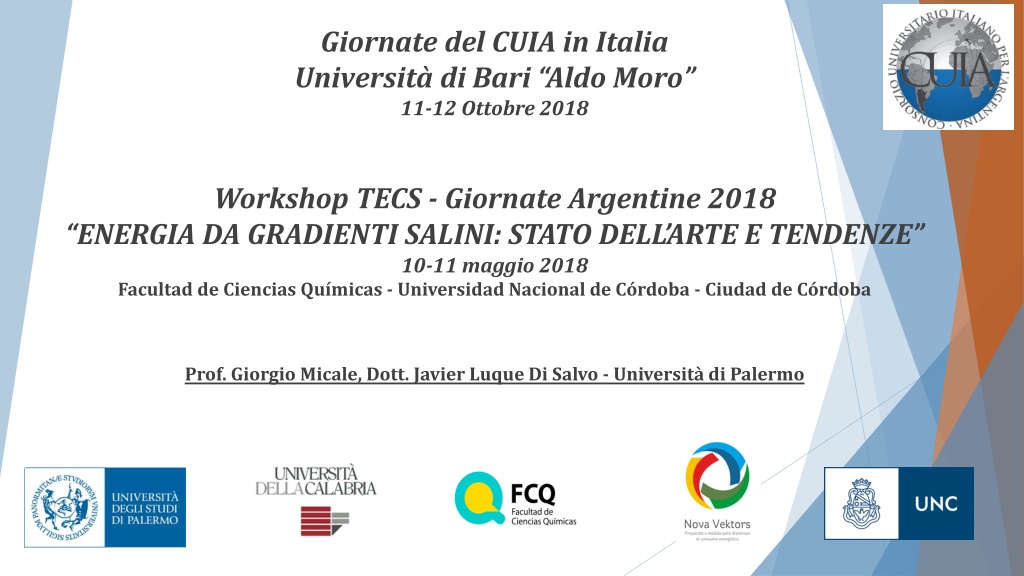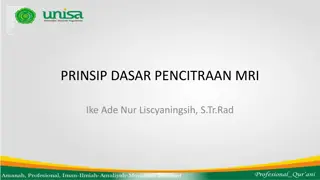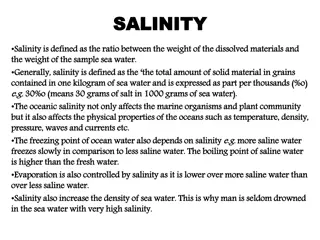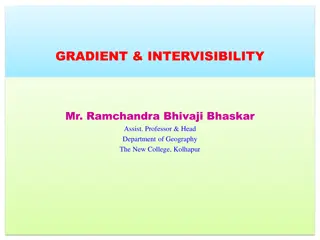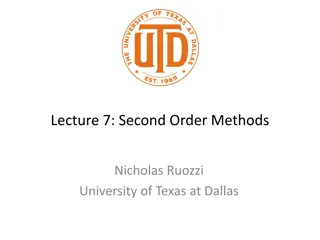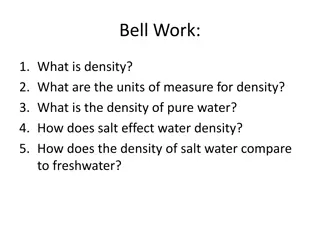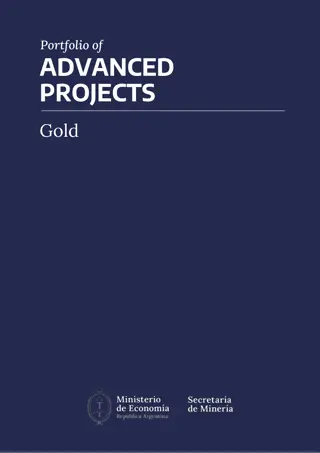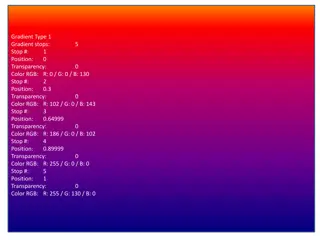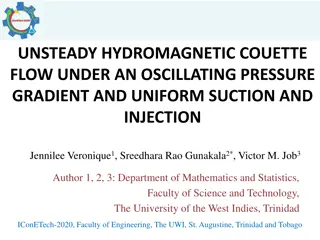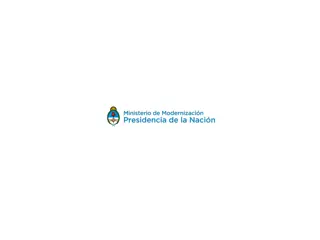Salinity Gradient Energies Workshop in Argentina
The potential of Salinity Gradient Energies (SGE) at the workshop held at Universidad Nacional de Córdoba. Learn about SGE technologies, research interests, and application sites. Discover the energy production potential and pilot plant experiences of Reverse Electrodialysis. Join efforts to promote sustainable energy production and water treatment innovations.
Download Presentation

Please find below an Image/Link to download the presentation.
The content on the website is provided AS IS for your information and personal use only. It may not be sold, licensed, or shared on other websites without obtaining consent from the author.If you encounter any issues during the download, it is possible that the publisher has removed the file from their server.
You are allowed to download the files provided on this website for personal or commercial use, subject to the condition that they are used lawfully. All files are the property of their respective owners.
The content on the website is provided AS IS for your information and personal use only. It may not be sold, licensed, or shared on other websites without obtaining consent from the author.
E N D
Presentation Transcript
Giornate del CUIA in Italia Universit di Bari Aldo Moro 11-12 Ottobre 2018 Workshop TECS - Giornate Argentine 2018 ENERGIA DA GRADIENTI SALINI: STATO DELL ARTE E TENDENZE 10-11 maggio 2018 Facultad de Ciencias Qu micas - Universidad Nacional de C rdoba - Ciudad de C rdoba Prof. Giorgio Micale, Dott. Javier Luque Di Salvo - Universit di Palermo
Outline Objectives. A glance into Salinity Gradient Energies concept (SGE). Workshop location Workshop program and execution. Outcomes and future perspectives
Objectives 1) Introduce to Argentinian partners the state-of-the-art of Salinity Gradient Energies, and related technologies. 2) Identify potential application sites for SGE. 3) Find common research interests in order to join efforts and promote the research among participants. Why Cordoba? In 2014, it started to function the new Laboratorio de Energias Sustentables (LaES) . The main research activities are the experimental synthesis of novel electrodes for lithium batteries. Many researches on this field also work at DQTC, with expertise in atomistic and nanoscale modelling. Research activities at UNIPA and UNICAL/ITM Membrane-based technologies for water treatment and sustainable energy production. Process design, optimization and multi-scale modelling. Currently, 5 (five) EU-funded projects at different stages of execution are being developed at UNIPA.
Salinity Gradient Energies The osmotic pressure of sea-water is about 20 atmospheres, so that when a river mixes with the sea, free energy equal to that obtainable from a waterfall 680 ft. high is lost R.E. Pattle (1954) The solubility of sodium chloride is almost independent of temperature and, in accord with Le Chatelier s principle, it has a very small heat of dilution. As a consequence, a large untapped source of energy has gone generally unrecognized G.L. Wick (1977) REVERSE PRESSURE RETARDED OSMOSIS (PRO) ELECTRODIALYSIS (RED) HIGH Other SGE-related technologies: + - - - - - - LOW LOW - - Hydrocratic generator + + + - - Capacitive Mixing - + + - Capacitive RED (CRED) - + - + - - Microbial RED + + + +- - Hybrids with parental + + technologies (RED/ED, etc.) Water Permeable Membrane LOW SALINITY HIGH SALINITY Ion Exchange Membranes
Reverse Electrodialysis Worlwide energy production potential of SGE technologies: e- HIGH out - 5177 TWh (23% of electricity consumption) - Practically available: 625 TWh (3%) LOW out Cell-pair OX OX + - - - - - - - Pilot plant experiences: e- + + + - RED RED - Afsluitdijk (The Netherlands, Blue Energy project): 50 kW projected. - Trapani (Italy, REAPower project): 350 700 W of energy production with 2 small RED units, by adopting brine as feed. - + + - + + - - + + + +- + + HIGH in Ion Exchange Membranes LOW in
Location Universidad Nacional de C rdoba It was founded on 1613 (oldest of Argentina). 11,5 km2 of land, 0.4 km2 of built facilities (in City of Cord ba). 15 Faculties, 145 Research centers, 4 radio/TV channels, among other facilities. 132.000 students (2018 stats). C rdoba: 2 most populated city of Argentina (1.535.868)
Participants: Giorgio Micale, Javier Luque Di Salvo (Univ. di Palermo) Stefano Curcio, Giorgio De Luca (Univ. della Calabria, Istituto per la Tecnologia delle Membrane) Daniel Barraco, Ezequiel Leiva, Guillermina Luque, Manuel Garcia, Maria Rojas, Agustin Alvarez Ojeda, Francisco Garcia (Univ. de Cordoba) | Oscar Oviedo (Nova Vektors) May 10th, Thursday May 11th, Friday 09:10 General picture of (renewable) energies in Argentina (Nova Vektors) Electrode materials for lithium batteries: theory and experiment (UNC) 10:15 Salinity Gradients Energy (SGE) fundamentals (UNIPA) Brine valorisation (UNIPA) Open Seminars (break) 11:15 Reverse Electrodialysis (RED): benchmarks and actual challenges (UNIPA) Ab initio computational modelling of nanostructures (UNICAL/ITM) 12:00 SGE research projects at Universit degli Studi di Palermo (UNIPA) Ion Exchange Membranes: A broad field of applications (UNIPA-UNICAL/ITM) 14:00 18:30 Experimental Experimental demonstration Experimental demonstration
Reverse Electrodialysis How to profit a short-time first meeting? Open seminars + Experimental tests Elenco del materiale necessario per le dimostrazioni sperimentali - Unit di Elettrodialisi Inversa (RED) composta da: o Due (2) piastre di plexiglas contenenti elettrodi solidi. o Pacco celle immerso in acqua e sale in una busta trasparente, contenenti membrane a scambio anionico e cationico (membrane di base polimerica) e spaziatori di poliacrilamida. o Attrezzature varie (tubi, raccordi, vite, ecc.) - Tre (3) pompe peristaltiche. - Un (1) carico esterno contenenti resistenze elettriche.
May 10, Thursday Seminars 09:10 General picture of (renewable) energies in Argentina (Nova Vektors) 10:15 Salinity Gradients Energy (SGE) fundamentals (UNIPA) (break) 11:15 Reverse Electrodialysis (RED): benchmarks and actual challenges (UNIPA) 12:00 SGE research projects at Universit degli Studi di Palermo (UNIPA) Experimental demonstration 14:00 18:30 Experimental tests using the RED unit fed by NaCl solutions of different concentration. Electrical characterization of the RED unit. Identification of potential application sites for RED technology in Argentina. Soluzione salina diluita NaCl 0.017M (river) Soluzione salina concentrata NaCl 0.5 M (seawater) Feed velocity effect Test 1 Test 2
May 11, Friday Seminars 09:10 Electrode materials for lithium batteries: theory and experiment (UNC) 10:15 Brine valorisation (UNIPA) (break) 11.15 Ab initio computational modelling of nanostructures (UNICAL/ITM) 12:00 Ion Exchange Membranes: A broad field of applications (UNIPA-UNICAL/ITM) Experimental Demonstration 14:00 18:30 Power density increase by adopting higher salinity streams, like brines. Open discussion: Could RED and/or parent IEM technologies be integrated to the lithium extraction process? Soluzione salina diluita NaCl 0.017M (river) NaCl 0.5 M (seawater) Soluzione salina concentrata NaCl 5 M (brine) NaCl 5 M (brine) Test 1 Test 2
Outcomes and perspectives Lithium triangle , lithium brines Brine management IEM-based technologies IEM-based technologies Lithium triangle , lithium brines Brine management 1 1 Mar Chiquita salt-lake as a potential site for RED pilot plant installation 2 2 3 3 Low-cost Multi-scale modelling Low-cost Multi-scale modelling
Outcomes and perspectives Ba ados del R o Dulce R o I Miramar (2K population) R o II
Outcomes and perspectives - Fluctuating salinity, strongly depends on precipitations. - Current possible scenarios: from 40 g/l to 120 g/l. Bucher, E. and Bucher A. Chapter 5: LIMNOLOGIA FISICA Y QUIMICA in MAR CHIQUITA LAGO SALADO, CORDOBA, ARGENTINA , ACADEMIA NACIONAL DE CIENCIAS, C RDOBA, ARGENTINA, 2006.
Outcomes and perspectives Pilot plant projection in Mar Chiquita ? 800 Estimated power produced by a single RED unit 700 600 Expected power (W) 500 o 1000 cell-pairs 400 300 o Fluid velocities 1 cm/s (4 m3/h needed) 200 o Flow rates Rivers I and II: 36000 m3/h each 100 (minimum). 0 40 80 120 o No flow rate limitations on seawater availability Salinity (g/l) expected. o Feed Spacers 270 m. Detailed pilot plant projection on going
Giornate Argentine 2018 Workshop TECS ENERGIA DA GRADIENTI SALINI: STATO DELL ARTE E TENDENZE Grazie! Gracias!
